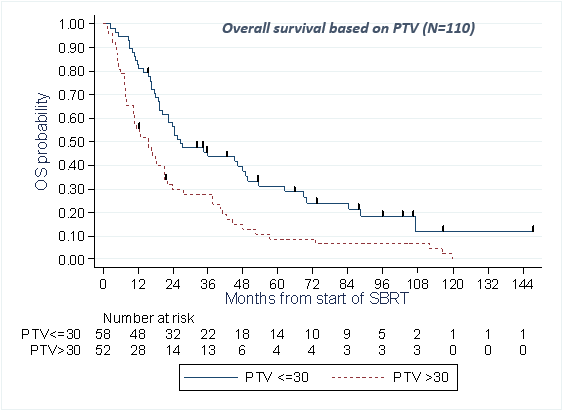Efficacy and tolerance of stereotactic re-irradiation in the treatment of head and neck cancers
PO-1237
Abstract
Efficacy and tolerance of stereotactic re-irradiation in the treatment of head and neck cancers
Authors: Xavier Liem1, Chloé Delerue1, Emilie Bogart2, Xavier Mirabel1, Séverine Lals1, Maël Barthoulot2, Julien Laffarguette3, Eric Lartigau1, David Pasquier1
1Oscar-Lambret Center, Radiotherapy, Lille, France; 2Oscar-Lambret Center, Clinical Research and Innovation, Lille, France; 3Oscar-Lambret Center, Medical Physics, Lille, France
Show Affiliations
Hide Affiliations
Purpose or Objective
Stereotactic radiotherapy potentially treats unresectable recurrences of previously irradiated head and neck (H&N) cancer. This study aimed to evaluate its efficacy and tolerance.
Material and Methods
This observational, retrospective, monocentric study investigated patients who had undergone 36-Gy, six-fraction stereotactic re-irradiation (CyberKnife®) for recurrent/secondary H&N cancer between 2007 and 2019 at the Oscar Lambret Center. Patient characteristics and toxicities were assessed. Overall survival (OS) was estimated using the Kaplan–Meier method. OS and toxicity prognostic factors were determined using a Cox model.
Results
110 patients were included from analysis, treated between January 2007 and December 2020. The median follow-up time was 106.3 months. The 2-year OS rate was 43.8% (95% confidence interval: 34.3–52.9; median survival: 20.8 months [16.5–26.3]). The cumulative 2-year local-recurrence, regional-recurrence, and distant-metastasis rates were 52.2% (42.4–61.1%), 12.8% (7.4–19.8%), and 11% (6.0–17.6%), respectively. In the multivariate analysis, performance status (HR[PS1]=2.05[1.19–3.56]; HR[PS2–3]=5.31[2.47–11.4], p<0.001), and planning target volume (HR=1.07[1.00–1.13], p=0.037) were significantly associated with mortality risk. 73 patients received concomitant cetuximab, and it was not significantly beneficial (HR=1.34[0.80–2.26], p=0.26). Forty six patients had grade 3+ acute toxicity and 42 grade 3+ late toxicity. Two grade 4 bleeds and no treatment-related deaths were reported.

Conclusion
Our results are consistent with those reported in the literature. Stereotactic re-irradiation of recurrent/secondary H&N cancer is feasible. However, local-recurrence rates remain non-negligible, warranting further research. Radiosensitizer use is currently under study. Therefore, establishing a balance between therapeutic modifications and toxicity is essential.